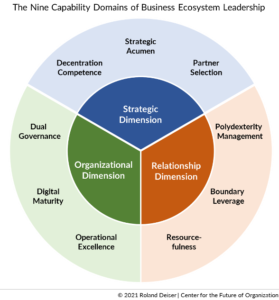
For many executives – especially those who lead traditional businesses – the prospect of engaging in business ecosystems is confusing if not threatening. Many are in the midst of major digital transformation projects which already are uprooting established routines; now they discover that it is not enough to just harvest the low hanging fruit of leveraging digital technology for improving current products, processes, and routines. To achieve growth and innovation via business ecosystems they must radically rethink the foundations of strategy, organization, and leadership.
Business ecosystem leadership is different from leading within the regulated space of your company. It means leading beyond your company’s boundaries, without pre-set rules, without traditional top-down authority. It means designing your strategy, operations, and relationships in consideration of the others. It means leading in a way that has a constructive impact not only on your firm but on the strategy, structure, and dynamics of the entire ecosystem.
Such thinking does not go well with traditional concepts of management and organization that are designed to maximize the performance and profit of a single player. Most companies’ operating models are fine-tuned to perform along the “single-player-rationale”. Consequently, their relationships are transactional, not collaborative relationship models, and the mindsets of their leaders and their workforce are conditioned accordingly.
It’s a tough challenge to reframe cognitive lenses and to reinvent the very foundations of your business operations along the way. What makes things even harder – we still have a quite limited understanding of what it takes to engage in business ecosystems in a way that leverage its ecosystem potential. No wonder that it is, as I said already, a confusing and threatening topic for many.
The capability framework I am going to share via this newsletter is an effort to provide a guideline for successful business ecosystem engagement. Before we go into details it may be helpful to structure the arena by distinguishing three interrelated fundamental dimensions that are equally important to consider: Ecosystem Strategy, Ecosystem Organization, and Ecosystem Relationships.
- The Strategy Dimension
It is important to understand that ecosystem engagement requires two levels of strategic thinking: the ecosystem strategy of an organization, and the strategy of the ecosystem itself. The latter runs contrary to the traditional aim of maximizing a company’s success at the expense of others. Mindsets that are anchored in competitive zero-sum thinking and that pursue one-sided, egocentric advantage are incompatible with the win-win architecture that is indispensable for successful ecosystem performance. The strategic rationale of the ecosystem is as important as the strategies of the individual players. Ecosystem leaders excel in marrying these two strategic thrusts. - The Organizational Dimension
Ecosystem engagement also requires a different level of organizational design sophistication that recognizes and addresses the interplay between the larger system dynamics and the structures, systems, processes, and culture of the individual organization. Command-and-control-based operating principles may work well within the boundaries of a company; they become dysfunctional in the context of an ecosystem that requires a collaborative approach to governance that limits the power of individual players. Cumbersome, bureaucratic decision processes are poison for collaboration and co-creation, which thrive on flexibility, agility, and speed. In a nutshell, the diseases of the 20th century organization are antithetic to the requirements of ecosystem formation and leadership. - The Relationship Dimension
Finally, to succeed in business ecosystems, organizations must excel in a complex level of relationship management. Ecosystem engagement comes with significant investments in a diverse portfolio of relationships. Each relationship comes with its own dynamic and requires a distinctive treatment of shared boundaries. An important element of productive boundary management is striking an optimal balance between openness and safeguarding. This poses a major challenge for many organizations; inward orientation and silo culture make it hard to reach across the aisle and create the trust and compassion that is so critical in the more informal, underregulated context of an ecosystem.
Each of the three dimensions is important, each dimension poses major challenges for existing operating models, mindsets, and leadership practices. The good news is that the inevitable dynamics of digital transformation in business and society will force more and more organizations to rethink the way they strategize, their modus operandi, and their rules of engagement with the outside world. In this sense, ecosystem participation becomes a unique strategic and organizational learning opportunity, a transformational force that reverberates back and challenges the very essence of a company’s approach to doing business.
Outlook: Three Dimensions, Nine Domains
The next few newsletters will be dedicated to a closer look at these three dimensions. For each dimension I will introduce and discuss three subdomains. Structured along ecosystem strategy, organization, and relationships, these nine capability domains form a powerful combination of elements that provide a guideline for companies who want to thrive in the new ball game called ecosystem leadership.
Check out the exhibit below for a preview of what to expect!




